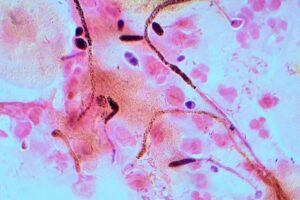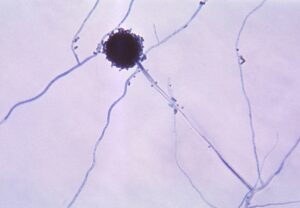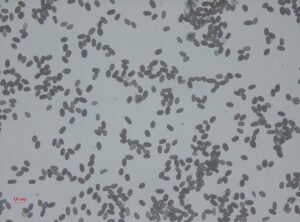The study of fungi that causes diseases to humans is known as the medical mycology. While, the study of fungi those are pathogenic or that causes diseases to plants is known as the plant pathology. In the world, there are around 300 fungi that are till now known to cause diseases to human being.
- Candida albicans
- Aspergillus acidus
- Cryptococcus neoformans
- Histoplasma capsulatum
- Pneumocystis jirovecii
- Stachybotrys alternans
- Talaromyces marneffei
- Blastomyces dermatitidis
- Emmonsia pasteuriana
- Sporothrix schenckii
Dimorphic fungi that are important pathogens of humans include other animals such as Paracoccidioides brasiliensis and Coccidioides immitis/posadasii.
Pathogenic fungi are fungi that are responsible for causing diseases in plants, humans, and different organisms. Though fungi are eukaryotic in nature, there are several pathogenic fungi that are microorganisms.
We will discuss a few pathogenic fungi examples here. These are species of different pathogenic fungi that has different genus:
1. Candida albicans
Candida albicans is an aggressive kind of pathogenic yeast. It is popular member found in the gut flora of humans. It can also exist independently of the human body.
In roughly 40 percent to 60 percent of healthy persons, Candida albicans is found in the gastrointestinal tract as well as the mouth. This species belongs to the genus named Candida that is responsible in causing Candidiasis which is a human infection.
This is the result of the fungus when there is an overgrowth. Candidiasis is one example that is often observed in patients who are HIV-infected.

Candida albicans is usually used as a model organism in the case of fungal pathogens. It’s known as a dimorphic fungus because it can grow both as yeast and as filamentous cells.
2. Aspergillus acidus
Aspergillus is the genus of moulds that can be found in a variety of conditions around the world. It consists of species that can be a few hundred mold.
Aspergillus acidus is one of the species that belong to this genus. This species, Aspergillus acidus, is used in the form of food fermentation for tea. The species of Aspergillus are necessary both medically and commercially. Some animals and humans can become infected with some of the species.
The term “aspergillosis” describes that group of diseases that are caused by the source of the fungus Aspergillus. Fever, cough, chest pain, or shortness of breath are all symptoms that can occur with a variety of other disorders, making diagnosis challenging. In humans, the fungus Aspergillus can cause some of the major forms of disease. They are as follows:
- Patients who suffer from allergic bronchopulmonary aspergillosis (ABAS)-this affects patients who suffer from respiratory diseases such as asthma, sinusitis, and cystic fibrosis.
- Acute invasive aspergillosis: this is a form of disease that grows into surrounding tissues. This disease is generally common in people who have weak immune systems, such as patients suffering from AIDS and also cancer patients who are undergoing chemotherapy.
- Disseminated invasive aspergillosis – this is an infection that spreads widely throughout the body.
- Aspergilloma – this is a “fungus ball” that has the ability to form within cavities such as the cavities of the lungs.

3. Cryptococcus neoformans
Cryptococcus neoformans is a soil-borne obligate aerobe that can live in both plants and animals.It belongs to the class named Tremellomycetes of encapsulated yeasts.
It’s frequently discovered in bird faeces in the form of yeast. Cryptococcus neoformans can infect both immunocompetent and immunocompromised hosts, causing illness. Cryptococcus neoformans reproduces by budding and develops as a form of yeast which is unicellular in nature.
Cryptococcosis is the result of a Cryptococcus neoformans infection. The majority of Cryptococcus neoformans illnesses originate in the lungs. Cryptococcus neoformans is transmitted to humans through the intake of aerosolized basidiospores, and it can move to the central nervous system, causing meningoencephalitis.
The infection begins in the lungs and spreads through the bloodstream to the meninges and eventually to other areas of the body. Phagocytosis is inhibited by capsules. In general, diabetic and hosts with weakened immune systems, it can produce a systemic infection.
It may include deadly meningitis known as meningoencephalitis. Fluconazole is a solo therapy that can be used to treat cryptococcosis which does not put any impact on the central nervous system.
4. Histoplasma capsulatum
Histoplasma capsulatum is a kind of species that belong to the dimorphic fungus. Its reproductive form is known as the Ajellomyces capsulatus.
Pulmonary and disseminated histoplasmosis can be caused by Histoplasma capsulatum. Histoplasma capsulatum is commonly found in the Midwest and East of the United States. It is connected by Central and South America, and also some other parts of the planet.
Histoplasma capsulatum is spread all over the world, except in Antarctica. Most typically this species is associated with river basins. Histoplasma capsulatum is especially common in the areas of Ohio and regions of Mississippi River.
Histoplasmosis can spread through the bloodstream to affect the internal organs and tissues. This, however, occurs in a limited number of cases.
Half or more of these instances involve hosts that have weakened immune systems. Endocarditis and peritonitis are the two more diseases that are seldom related with the species, Histoplasma capsulatum.
5. Pneumocystis jirovecii
Pneumocystis jirovecii is a type of fungus which has yeast like characteristics. It belongs to the genus named Pneumocystis.
Pneumocystis pneumonia is caused by this bacterium, which is a serious human infection, especially in people who are immunocompromised. Pneumocystis pneumonia is a significant disease of immunocompromised humans, especially in patients with HIV.
It is also necessary to patients, whose immune system is critically terminated for several other reasons, such as, as a result of a bone marrow transplant. It is a very prevalent asymptomatic severe disease with a strong immune system in human beings.
The drugs that can be used to treatments are Trimethoprim or sulfamethoxazole, pentamidine, dapsone. The majority of instances in HIV patients happen whenever the CD4 level falls under 200 cells per microliter.
P. jirovecii is considered to have both an androgynous phase and stages where both the parents are involved in its life cycle. Binary fission is most likely how haploid cells multiply asexually. Primary homothallism, also known as self-fertilization, seems to be the method of reproduction where both the parents are included. The reproductive phase occurs in the lungs of the host.
6. Stachybotrys chartarum
The microfungus Stachybotrys chartarum, often considered as black mould or toxic black mould, generates its conidia or spores in slime bodies. It can be seen in soil and grain such as wheat, corn, cereal.
The bacteria Stachybotrys chartarum has recently been linked to a condition is known as sick building syndrome. Stachybotrys chartarum has two chemotypes: one that generates trichothecene mycotoxins such satratoxin H and another that forms atranones.
S. chartarum is a mold that usually grows slowly mould that has a tough time competing with other moulds. It is infrequently encountered in nature, and it rarely encounters the kind of living environment that human occupation can occasionally provide.

Most indoor air contaminants are considered infrequent. But the conidia are commonly present in cellulose-rich construction materials from wet or water-damaged structures, for example, wallpaper and drywall that are gypsum-based.
Stachybotrys chartarum takes time to grow. That means it is a slow-growing fungus and it does not take part in any competition against any other molds. This kind of fungus is hardly found in nature.
It is infrequently encountered in nature, and it rarely experiences the kind of living situation that human occupation can occasionally provide. Most indoor air contaminants are considered infrequent.
7. Talaromyces marneffei
In 1956, Talaromyces marneffei, which is formerly known as Penicillium marneffei, was discovered. The organism is indigenous to Southeast Asia, where it is a leading source of opportunistic diseases living with HIV/AIDS.
T. marneffei causes human diseases known as talaromycosis. They have also been recorded in HIV-positive patients present in Australia, Europe, Japan, the United Kingdom, and the United States.
Except for one, all of the patients had already visited Southeast Asia. The condition is thought to be an AIDS-defining sickness. Treatment for talaromycosis varies depending on the severity of immunosuppression and involvement of organ.
However, most Talaromyces marneffei isolates have low MICs. They have low MICs for posaconazole, amphotericin B, voriconazole, and itraconazole.
8. Blastomyces dermatitidis
Blastomycosis is a type of disease that is caused by the fungus named Blastomyces dermatitidis. It causes an aggressive and frequently fatal fungal sickness in humans and other animals in endemic areas.
This fungus is often present in soil, decaying wood which is wet, in places those are close to water bodies for example stream, lake or river. Blastomyces dermatitidis can also be found in indoor areas such as in accumulated debris in moist sheds or shacks.
The fungus, Blastomyces dermatitidis, is native to the following areas:
- Eastern North America, specifically boreal northern Ontario and southeastern Manitoba
- Quebec south part of the St. Lawrence River,
- Few regions from the US Appalachian Mountains
- Eastern mountain chains that are interconnected
- The west coast of Lake Michigan, Wisconsin, and the entire area of Mississippi Valley
- Valleys from few important tributaries such as the Ohio River.
It is considered to grow as a form of cottony white mould in the environment, which is same to the growth present in artificial culture at a temperature of 25 °C or 77 °F.
9. Emmonsia parva
Emmonsia parva, E. crescens, and E. pasteuriana altogether form the genus named Emmonsia. But still they show different ecological features of their own.
Emmonsia parva, also known as Chrysosporium parvum, is a saprotrophic fungus that has filaments, and this is one of three species that belong to the genus Emmonsia. The fungus is dimorphic in nature and grows in two distinct forms.
At ambient temperature, it develops as hyphae, but whenever conidia are heated to a temperature of 40 °C, they transform into bigger adiaspores. The fungus is well known for its link to adiaspiromycosis, a lung sickness that most typically affects small mammals but can potentially affect people.
While E. crescens is distributed all over the world, E. parva is only found in places like North and South America, Eastern Europe, Australia, and Asia. The fungus is predominantly a saprotroph, meaning it feeds on decaying matter.
10. Sporothrix schenckii
Sporothrix schenckii, a fungus prevalent in the environment all over the world, is named after medical student Benjamin Schenck, who was the first to isolate it from a human specimen in 1896.
The species can be found in soil, as well as live and decaying plant material like peat moss. It is the cause of sporotrichosis, sometimes also known as the “rose handler’s disease,” and can affect both humans and animals. Sporothrix schenckii can be present in either hyphal or yeast morphologies.
Sporothrix schenckii develops its hyphal morphology when growing in the nature or in the laboratories at a temperature of 25 °C or 77 °F. Colonies are wet, leathery to velvety, and have a highly creased surface when viewed under a microscope.
The color starts with white and gradually changes to cream and then to dark brown over time. This color is also known as “dirty candle-wax” color. When observed under microscope, hyphae are septate and have a diameter of 1 to 2 m.
At a temperature of 37 °C or 99 °F, Sporothrix schenckii develops its yeast nature either in the tissues of the host or in the laboratories. When observed macroscopically, the form of the yeast seems as clear as white or off-white colonies. Yeast cells are 2 to 6 m long and have an extended cigar-shaped appearance under the microscope.
Non pathogenic fungi examples
The following are some of the most common nonpathogenic fungus strains identified to cause ISR in crop plants:
- Mycorrhiza,
- Trichoderma sp.
- Penicillium sp.
- Fusarium sp.
- Phoma sp., etc.
Innate immunity has been shown to be triggered by a variety of signalling pathways, including salicylic acid, jasmonic acid, and ethylene.
Conclusion
There are different ways in which fungi can cause diseases. They are: replication of the fungus where fungal cells occupy tissues and disturb their functions, Immune response with the help of immune cells or antibodies Competitive metabolism by consuming the source of energy and nutrients stored for the host.
Also Read:
- Creeper plant example
- Polycarpic plant example
- Do prokaryotes have rna
- Are bacteria microorganisms
- Function of plasmid in bacteria
- Are cell wall an organelle
- Does the krebs cycle produce water
- Do animal have enzymes
- Cytoplasm in white blood cell
- Chromosome functions in animal cell

Hi, I am Milanckona Das and pursuing my M. Tech in Biotechnology from Heritage Institute of Technology. I have a unique passion for the research field. I am working in Lambdageeks as a subject matter expert in biotechnology.
LinkedIn profile link-